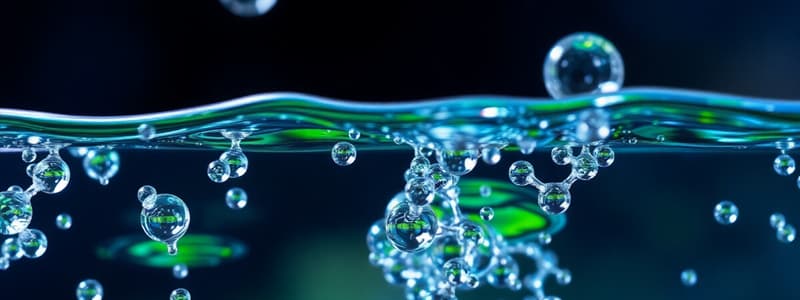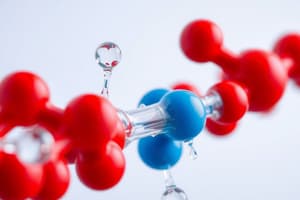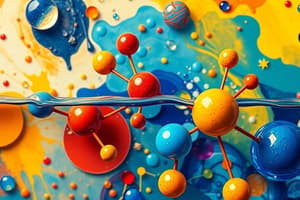Podcast
Questions and Answers
What property of water allows it to absorb a lot of energy before its temperature increases?
What property of water allows it to absorb a lot of energy before its temperature increases?
- Density
- Solvency
- High specific heat capacity (correct)
- Cohesion
Ice is denser than liquid water.
Ice is denser than liquid water.
False (B)
What range of pH levels is considered normal for blood?
What range of pH levels is considered normal for blood?
7.35-7.45
Water is classified as a __________ molecule because it can dissolve many substances.
Water is classified as a __________ molecule because it can dissolve many substances.
Match the following terms with their definitions:
Match the following terms with their definitions:
What are organic molecules characterized by?
What are organic molecules characterized by?
Hydrogen bonds are essential for the structure of water molecules and have significant implications for life.
Hydrogen bonds are essential for the structure of water molecules and have significant implications for life.
What is a hydrocarbon?
What is a hydrocarbon?
Which type of biological molecule is primarily composed of carbon, hydrogen, and oxygen and includes monosaccharides?
Which type of biological molecule is primarily composed of carbon, hydrogen, and oxygen and includes monosaccharides?
Triglycerides are stored in muscle cells in the human body.
Triglycerides are stored in muscle cells in the human body.
What is the term for the linkage formed between two monosaccharides?
What is the term for the linkage formed between two monosaccharides?
Steroids are made up of ______________ carbon rings.
Steroids are made up of ______________ carbon rings.
Match the following biological macromolecules with their primary functions:
Match the following biological macromolecules with their primary functions:
What type of bond is formed during the synthesis of proteins?
What type of bond is formed during the synthesis of proteins?
Eicosanoids are classified as lipids.
Eicosanoids are classified as lipids.
What are the monomers of proteins called?
What are the monomers of proteins called?
Lipids are primarily ____________ molecules, meaning they do not dissolve in water.
Lipids are primarily ____________ molecules, meaning they do not dissolve in water.
Match the type of fat with its classification:
Match the type of fat with its classification:
Humans lack the enzyme necessary to break down which polysaccharide?
Humans lack the enzyme necessary to break down which polysaccharide?
Hydrogen bonds play a role in stabilizing the tertiary structure of proteins.
Hydrogen bonds play a role in stabilizing the tertiary structure of proteins.
What is the primary structure of a protein determined by?
What is the primary structure of a protein determined by?
The energy storage polysaccharide in animals is called ____________.
The energy storage polysaccharide in animals is called ____________.
What is the role of enzymes in biological reactions?
What is the role of enzymes in biological reactions?
All proteins are biologically active regardless of their structure.
All proteins are biologically active regardless of their structure.
What are the inactive forms of enzymes called?
What are the inactive forms of enzymes called?
DNA is ____ transcribed ____ to RNA.
DNA is ____ transcribed ____ to RNA.
Match the type of RNA with its primary function:
Match the type of RNA with its primary function:
Which of the following describes the structure of ATP?
Which of the following describes the structure of ATP?
In RNA, the pentose sugar is deoxyribose.
In RNA, the pentose sugar is deoxyribose.
What is the primary structure that forms the backbone of DNA and RNA?
What is the primary structure that forms the backbone of DNA and RNA?
The change in the nucleotide sequence of DNA is called a mutation.
The change in the nucleotide sequence of DNA is called a mutation.
Which of the following components is NOT part of a nucleotide?
Which of the following components is NOT part of a nucleotide?
Flashcards are hidden until you start studying
Study Notes
Water Properties
- Water exhibits cohesion, meaning water molecules stick to each other due to hydrogen bonding.
- Water moderates temperature by absorbing a lot of heat before its temperature increases, keeping daytime temperatures lower.
- At night, water releases heat back into the environment.
- Sweat is another example of water controlling temperature.
- Water expands upon freezing, making ice less dense than liquid water and allowing it to float.
- This is essential for freshwater organisms to survive winter.
- Water is an excellent solvent due to its polar nature.
- Polar and charged substances dissolve easily in water, making them hydrophilic.
- Nonpolar substances, like oils and lipids, are hydrophobic.
- Buffers minimize changes in pH levels.
- Blood, which is more than 90% water, must maintain a pH between 7.35 and 7.45.
- Hydrogen bonds play a crucial role in water molecules and life.
Organic Molecules
- Organic molecules contain carbon.
- Carbon skeletons are held together by covalent bonds.
- Hydrocarbon molecules only contain carbon and hydrogen.
- Functional groups are atoms or molecules attached to the carbon skeleton.
- Different functional groups give molecules different chemical properties, thus altering their function in cells.
Biological Monomers
- Biological molecules are complex organic compounds made from a few subunits, which are often polymers of monomers.
- There are four classes of biological monomers: carbohydrates, lipids, proteins, and nucleic acids.
Carbohydrates
- Carbohydrates are organic compounds consisting of carbon, hydrogen, and oxygen.
- They make up approximately 2-3% of the total body mass.
- Monosaccharides are the monomers of carbohydrates and are simple sugars.
- They’re linked together by dehydration synthesis.
- The resulting bond is called a glycosidic linkage.
- Disaccharides are formed by joining two monosaccharides.
- Polysaccharides are large molecules comprised of hundreds to thousands of monosaccharides.
- Glycogen, a branched chain of glucose monomers, is the storage polysaccharide in animals.
- Starches, linear chains of glucose monomers, are storage polysaccharides in plants.
- The main difference between glycogen and starch is the stereochemistry of the glycosidic bond between the monomers.
- Humans lack the enzyme to break the bonds in cellulose, a polysaccharide found in plants.
Lipids
- Lipids are hydrophobic molecules made of carbon, hydrogen, and a small proportion of oxygen.
- Lipids make up 18-25% of the total body mass in humans.
- There are many types of lipids:
- Fatty acids
- Triglycerides (fats and oils)
- Phospholipids
- Steroids
- Eicosanoids
- Fat-soluble vitamins
- Fatty acids are hydrocarbon chains with a carboxyl group at one end.
- Fatty acids can be saturated or unsaturated.
- Saturated fatty acids only have single covalent C-C bonds.
- Unsaturated fatty acids have one or more C-C double bonds.
- Triglycerides are composed of three fatty acids bonded to a glycerol backbone by ester bonds.
- Fats are triglycerides that are solid at room temperature, while oils are triglycerides that are liquid.
- Triglycerides are stored in fat cells called adipocytes.
- Saturated fats contain mostly saturated fatty acids and include butter and lard.
- Unsaturated fats can be either monounsaturated or polyunsaturated:
- Monounsaturated fats, like olive oil, canola oil, peanut oil, avocado oil and most nut oils, have one double bond.
- Polyunsaturated fats, like corn oil, safflower oil, sunflower oil, soybean oil, and fatty fish oils, have two or more double bonds.
- Phospholipids are composed of a glycerol backbone covalently linked to two fatty acids and a phosphate group.
- Phospholipids are amphipathic molecules with a polar phosphate “head” (hydrophilic) and nonpolar fatty acid ”tails” (hydrophobic).
- Steroids are formed by four fused carbon rings.
- Cholesterol is the precursor to many steroid hormones in the body.
- It’s an essential component of biological membranes and acts as a fluidity buffer.
- Sterols, steroids with at least one hydroxyl group, are slightly amphipathic due to the hydroxyl group.
- Eicosanoids are 20-carbon compounds, including prostaglandins and leukotrienes, involved in immune signaling.
- Fat-soluble vitamins, including vitamins D, E, and K, are critical for human health.
Proteins
- Proteins are large molecules made of carbon, hydrogen, oxygen, and nitrogen.
- They make up 12-18% of the total body mass in humans and determine the structure of body tissues.
- Amino acids are the monomers of proteins, and there are 20 naturally occurring amino acids.
- Each amino acid has a central carbon atom bonded to three functional groups.
- Amino group (-NH2)
- Carboxyl group (-COOH)
- Side chain or R group, which confers unique chemical properties.
- Amino acids undergo dehydration synthesis to form a covalent bond, known as a peptide bond.
- Few amino acids form a peptide, while many (10–2000) amino acids join to form a polypeptide.
- Proteins can be composed of a single polypeptide chain (small proteins) or multiple folded polypeptide chains (large proteins).
- The structure of a protein determines its function.
- The primary structure of proteins is the amino acid sequence, which is determined by gene sequence.
- The secondary structure of proteins is characterized by the repeated folds of proteins, forming either α-helices or β-sheets.
- Secondary structure is stabilized by hydrogen bonds.
- The tertiary structure of proteins is a three-dimensional shape, determined by primary and secondary structures along with various bonds and atomic forces.
- Disulfide bridges, covalent S—S bonds between sulfhydryl groups, are involved in tertiary structure, along with hydrogen bonds, ionic bonds, and hydrophobic interactions.
- The quaternary structure of proteins describes the arrangement of polypeptide chains in multi-peptide proteins.
- Not all proteins have a quaternary structure because not all proteins are composed of multiple polypeptide chains.
- Fibrous proteins form long parallel bundles and are water-insoluble, for example, keratin (hair) or actin (muscle thin filaments).
- Globular proteins, characterized by round or "blob-like" shapes, are water-soluble and include antibodies and most enzymes.
- When proteins lose their structure, they become denatured and are biologically inactive.
Enzymes
- Enzymes are biological catalysts that accelerate the rate of chemical reactions without being consumed in the process.
- Some enzymes require nonprotein molecules, called cofactors.
- Organic cofactors are called coenzymes.
- Chemical reactions would proceed too slowly or not happen at all without enzyme-catalyzed reactions in the human body.
- Enzymes work by binding substrates at their active sites, forming a substrate-enzyme complex that facilitates a change in chemical bonds and atom arrangement.
- The products of the reaction are then released from the active site, allowing the enzyme to bind more substrates.
- Enzymes are highly specific: They bind specific reactants called substrates at their active sites, which fit together like a lock and key.
- Enzymes are efficient: They increase the rate of chemical reactions by lowering the activation energy required to break bonds.
- Enzymes are regulated: Cells control the synthesis and activity of enzymes.
- Proenzymes are inactive forms of enzymes that must be processed under specific conditions to become active, such as prothrombin, the inactive form of thrombin, which is involved in blood clotting.
Nucleic Acids
- Nucleic acids are made of carbon, hydrogen, oxygen, nitrogen, and phosphorus.
- There are two types: deoxyribonucleic acid (DNA) and ribonucleic acid (RNA).
- Genes, segments of DNA that code for specific proteins, are transcribed into RNA.
- RNA is then translated by ribosomes into proteins.
- The monomers of nucleic acids are nucleotides, which are composed of:
- Nitrogenous base
- Pentose sugar
- Phosphate group
- DNA contains four nitrogenous bases: adenine (A), guanine (G), cytosine (C), and thymine (T).
- RNA contains four nitrogenous bases: adenine (A), guanine (G), cytosine (C), and uracil (U).
- A and G are purines, which are double-ring bases.
- T and C are pyrimidines, which are single-ring bases.
- In DNA, the pentose sugar is deoxyribose, while in RNA, it is ribose.
- The phosphate groups and pentose sugars form the backbone of the molecule.
- Due to the chemical properties of nucleotides, DNA forms a double helix, with bases forming the “rungs” of the ladder.
- This structure was proposed by James Watson and Francis Crick in 1953.
- DNA is the genetic material in all living things.
- During DNA replication, a new copy of the double helix is made, using one strand as a template.
- A change in the nucleotide sequence of DNA is called a mutation.
- RNA is a single-stranded molecule, and there are three major types:
- Messenger RNA (mRNA): Encodes messages from genes to ribosomes.
- Ribosomal RNA (rRNA): Catalyzes chemical reactions as part of ribosomes.
- Transfer RNA (tRNA): Brings amino acids to ribosomes during translation.
- Adenosine triphosphate (ATP) is a biologically-important nucleotide that serves as the energy currency of cells.
- ATP consists of three phosphate groups bound to adenosine, which is composed of adenine and ribose.
- ATP is produced by exergonic cellular reactions and consumed by endergonic cellular reactions to drive cellular work.
- Hydrolysis of the terminal phosphate group in ATP releases a large amount of energy.
- ATP can be regenerated through ATP synthase during aerobic cellular respiration.
Summary
- Biological molecules are diverse organic molecules.
- The four classes of biological molecules are carbohydrates, lipids, proteins, and nucleic acids.
- Except for lipids, all biological molecules are polymers of monomers.
- The structure of biological molecules is closely related to their specific functions.
Studying That Suits You
Use AI to generate personalized quizzes and flashcards to suit your learning preferences.




